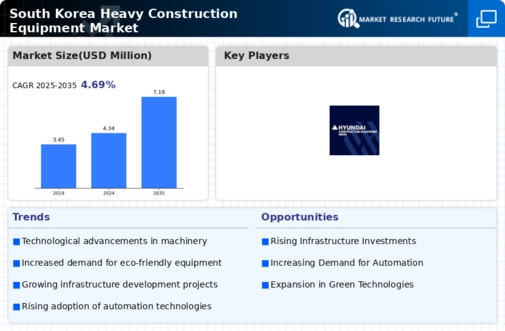Urbanization Trends
Rapid urbanization in South Korea is a significant driver for the heavy construction-equipment market. With over 80% of the population residing in urban areas, the demand for residential and commercial construction is on the rise. This urban expansion necessitates the development of new buildings, roads, and public facilities, which in turn increases the need for heavy construction equipment. The construction sector is projected to grow at a CAGR of 4.5% through 2025, indicating a robust market for heavy machinery. As cities expand, the requirement for advanced equipment that can operate efficiently in densely populated areas becomes crucial. Consequently, manufacturers are likely to innovate and adapt their offerings to meet the specific needs of urban construction, thereby enhancing their market position.
Government Infrastructure Spending
The heavy construction-equipment market in South Korea will benefit from increased government spending on infrastructure projects. The South Korean government has committed to investing approximately $200 billion in infrastructure over the next decade, which includes roads, bridges, and public transportation systems. This investment is expected to stimulate demand for heavy construction equipment, as contractors will require advanced machinery to meet project deadlines and specifications. Furthermore, the government's focus on enhancing urban infrastructure and rural development may lead to a surge in construction activities, thereby driving the heavy construction-equipment market. As a result, manufacturers and suppliers in this sector may experience growth opportunities, particularly in the production of excavators, bulldozers, and cranes, which are essential for large-scale construction projects.
Rising Demand for Rental Equipment
The heavy construction-equipment market in South Korea is witnessing a shift towards equipment rental services. As construction companies seek to optimize costs and reduce capital expenditures, the rental model is becoming increasingly popular. It is estimated that the rental market for heavy machinery could grow by 15% annually, driven by the need for flexibility and access to the latest equipment without the burden of ownership. This trend is particularly evident among small to medium-sized enterprises that may lack the financial resources to purchase expensive machinery outright. Consequently, rental companies are likely to expand their fleets and services, providing a wider range of options for contractors. This shift not only supports the heavy construction-equipment market but also encourages innovation in rental services and equipment maintenance.
Technological Advancements in Equipment
The heavy construction-equipment market is experiencing a transformation due to technological advancements. Innovations such as telematics, automation, and electric machinery are reshaping the industry landscape. In South Korea, the adoption of smart construction technologies is gaining traction, with an estimated 30% of construction companies integrating advanced machinery into their operations. These technologies not only improve efficiency but also reduce operational costs, making them attractive to contractors. As the demand for more efficient and environmentally friendly equipment grows, manufacturers are likely to invest in research and development to create cutting-edge solutions. This trend may lead to increased competition among equipment suppliers, ultimately benefiting the heavy construction-equipment market as a whole.
Focus on Sustainable Construction Practices
Sustainability is emerging as a critical driver in the heavy construction-equipment market. South Korea is increasingly prioritizing eco-friendly construction practices, which influences the types of equipment being utilized. The government has set ambitious targets to reduce carbon emissions, prompting construction companies to adopt greener technologies. It is projected that by 2026, 25% of new construction projects will incorporate sustainable practices, thereby increasing the demand for equipment that meets these standards. This shift may lead to a rise in the production of electric and hybrid machinery, as well as equipment designed for energy efficiency. As the heavy construction-equipment market adapts to these changes, manufacturers that prioritize sustainability may gain a competitive edge, aligning with the broader goals of environmental responsibility.












Leave a Comment